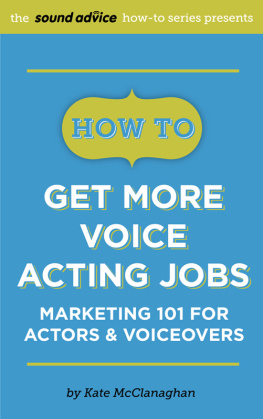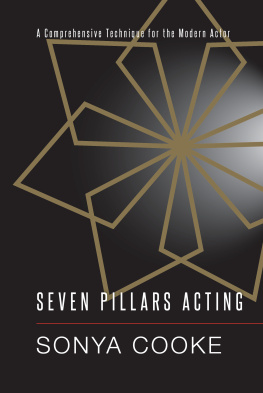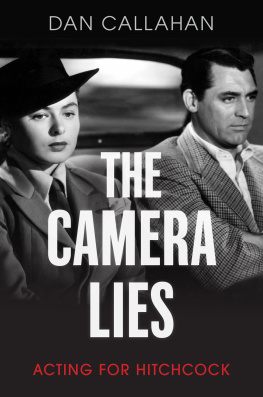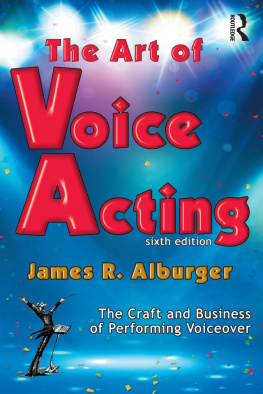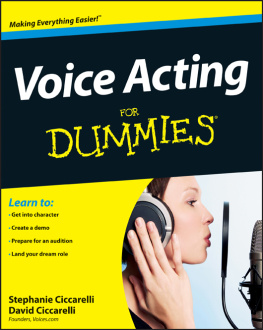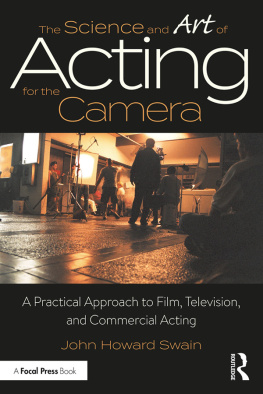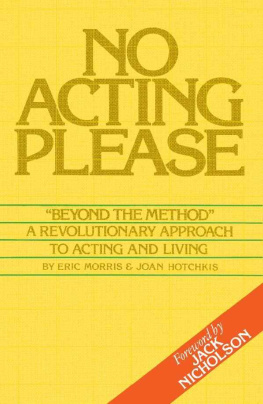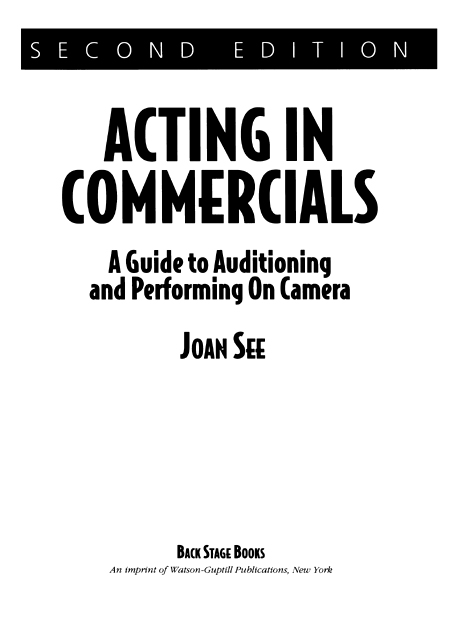Copyright 1993, 1998, by Joan See
First edition published in 1993 by Back Stage Books, an imprint of Watson-Guptill Publications, a division of BPI Communications, Inc., 1515 Broadway, New York, NY 10036-8986
All rights reserved. No part of this publication may be reproduced, stored in a retrieval system, or transmitted, in any form or by any means-electronic, mechanical, photocopying, recording, or otherwise-without prior written permission of the publisher.
This book was an editorial project of International Screen, Television & Entertainment Literature, Inc.
Acquiring editor: Dale Ramsey
Jay Anning
Production manager: Hector Campbell
Illustrations: Ron Crawford
Library of Congress Cataloging-in-Publication Data
See, Joan
Acting in commercials: a guide to auditioning and performing on camera/Joan See.
p. cm.
eISBN: 978-0-307-79951-7
1. Acting for television-Vocational guidance. 2. Television advertising-Vocational guidance. I. Title.
PN1992. 8. A3S441993
791. 45028025-dc20
v3.1
To my students, past and present
Acknowledgments
Writing is a humbling experience. As I recall the many sources of support I have required putting this book together, I realize how truly grateful I am for the journey that other acting teachers have taken before me: I am indebted to the work of Stella Adler and Uta Hagen for their succinct expression of the mysteries of acting; and Michael Caines insights on the camera-actor relationship reveal him to be more than just another accomplished movie actor. However, there is no way I would have been able to successfully work with actors if it had not been for the great Sanford Meisner. As a teacher, he always sought to solve the actors individual problem, and in doing so, he found new ways to teach us all. The concept of the reality of doing, one of the foundations of the Meisner approach, was a lesson I learned from Sandy long ago. It is a lesson that has never failed me in the moment of the test. It is the cornerstone of everything I know about acting.
Fine minds, great teachers, and excellent performers have touched my life and enriched my teaching. In particular, Richard Fonda and Mike Miller were wonderful actors and teachers; I miss them both. And my time spent on the Screen Actors Guild Board of Directors widened my knowledge of the business of this craft beyond measure.
The faculty of The School for Film and Television are a special group indeed. Their care and commitment to the actors of the future has always been the key ingredient of our success. They have shared with me their accumulated wisdom and vision. Without them, I could not have persevered. And when it comes to vision, creativity, and contribution to the School for Film and Television, Jack Newmans commitment to its development went a long way toward making it happen. And, of course, my love is always with the other two of Three of Us Corporation. When I didnt think I could make a future happen I found strength in my commitment to them.
As I ventured on this writing road, I needed to find courage. I owe affection and gratitude to Sonny Stokes for helping me find the map to it, and Casey Kelly, who has not only been my friend, but an inspiring example of writing discipline and bravery. I deeply appreciate the understanding and patience of my beloved agents at Cunningham, Escott, Dipene, particularly Ken Slevin and Carrie Morgan. They have always supported and encouraged me. When it comes to patience, John Istel, my editor, should win a prize.
There is no conservatory, studio, school, or theater without management. Behind the people who are center stage there are those who make it all possible. This industry is called show business not show art. David Palmer is the person who keeps The School for Film and Television shipshape, and he does it brilliantly. It would have been impossible for me to take this time to write if David and my school administrator, Marc Aronin, had not created an opportunity for me to be away from The School for days at a time. A young man of remarkable talents, Marc has also served as test reader and cheering section. My other cheering section, the illustrator and artist Ron Crawford, is the fastest and most wonderful collaborator any writer could have. Thank you, friends!
CONTENTS
P ART O NE
W ORKING IN C OMMERCIALS
P ART T WO
A CTING F UNDAMENTALS FOR C OMMERCIALS
P ART T HREE
C OMMERCIAL A CTING T ECHNIQUES
P ART F OUR
G ETTING B OOKED
Introduction
There have been a number of books written about commercials. The majority fall into the you-too-can-be-a-star genre. They aim to introduce the total beginner to the so-called glamorous world of commercials. They guide the reader through a general survey course in commercial acting, offering lessons in everything from What Is a Casting Director? to Getting Your Pet into Commercials. The best of these provide a nice overview of the industry and an introduction to the basics.
This book definitely does not take a you-too approach. It was never my desire to imitate the way that some people initiate the novice actor into this industry. I write from experience. I have lived through almost all of the feelings and frustrations regarding acting and auditioning for commercials that I discuss in this book. My training, first as an actor, and second as a successful actor in commercials, has given me a perspective different from most. (I should say here that I prefer to call all performers actors regardless of gender; after all, there are no doctoresses or pilotesses, and though there are waitresses, most of them are actors anyway.)
Years ago, when I began to teach, I decided to teach what I knew. I knew about an acting process; I didnt know magic tricks. I knew that my acting technique had always been the place to which I returned when everything else about performing seemed bewildering. I also knew that the directors and actors whom I respected in the business of making television commercials were craftspeople and artists. By working with such professionals, I learned how to adapt to and survive in what I first experienced as a hostile world.
In the old days, there was often time on a set to talk about acting and commercial film techniques with the director and crew. Likewise, agents had time to guide actors and explain the business to them. By the time I started teaching, most of that had changed.
It is easy to forget that the television industry is young and fast-moving. When I began in 1962, commercials had been organized by Screen Actors Guild for only two years. The golden age of the commercial had just begun. The golden goose had just begun to lay the golden eggs. What had started quietly in the 1950s had become a multibillion-dollar culture-shaping enterprise by the 1980s. Actors were as eager and vulnerable as ever, but now they were under siege in a pressured business climate that coldly used up new faces and only wanted more. Because so much money was being spent in the filming and broadcasting of television commercials, test marketing ruled what spots got on the air. Every client wanted the biggest market share they could get for the dollars they invested. Casting was considered critical. The pressure to find the right actor lead to casting by committee. Everyone had to have a say, and if the group couldnt agree on the one from a pool of twenty auditioning actors, then maybe a larger pool of forty might solve the deadlock.


